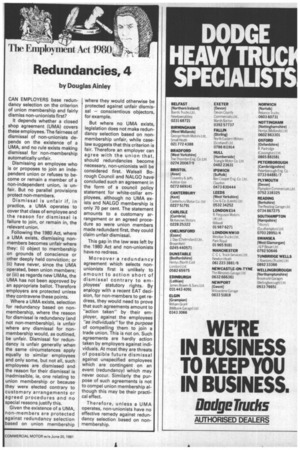Redundancies, 4
Page 59

If you've noticed an error in this article please click here to report it so we can fix it.
by Douglas Ainley
CAN EMPLOYERS base redundancy selection on the criterion of union membership and fairly dismiss non-unionists first?
It depends whether a closed shop agreement (UMA) covers these employees. The fairness of dismissal of non-unionists depends on the existence of a UMA, and no rule exists making dismissal for non-membership automatically unfair.
Dismissing an employee who is or proposes to join an independent union or refuses to become or remain a member of a non-independent union, is unfair. But no parallel provisions protect non-members.
Dismissal is unfair if, in practice, a UMA operates to cover that class of employee and the reason for dismissal is failure to join, or remain in, the relevant union.
Following the 1980 Act, where a UMA exists, dismissing nonmembers becomes unfair where they: (i) object to membership on grounds of conscience or other deeply held conviction; or (ii) have never, since the UMA operated, been union members; or (iii) as regards new UMAs, the UMA has not been approved by an appropriate ballot. Therefore employers are protected unless they contravene these points.
Where a UMA exists, selection for redundancy based on nonmembership, where the reason for dismissal is redundancy (and not non-membership), is unfair where any dismissal for nonmembership would, as outlined, be unfair, Dismissal for redundancy is unfair generally when the same circumstances apply equally to similar employees and only some, but not all, such employees are dismissed and the reason for their dismissal is inadmissible, ie, one relating to union membership or because they were elected contrary to customary arrangements or agreed procedures and no special reasons justify this.
Given the existence of a UMA, non-members are protected against redundancy selection based on union membership where they would otherwise be protected against unfair dismissal — conscientious objectors, for example.
But where no UMA exists, legislation does not make redundancy selection based on nonmembership unfair, while caselaw suggests that this criterion is fair. Therefore an employer can agree with the union that, should redundancies become necessary, non-unionists will be considered first. Walsall Borough Council and NALGO have concluded such an agreement in the form of a council policy statement for white-collar employees, although no UMA exists and NALGO membership is only 70 per cent. The statement amounts to a customary arrangement or an agreed procedure so were union members made redundant first, they could claim unfair dismissal.
This gap in the law was left by the 1980 Act and non-unionists have no redress.
Moreover a redundancy agreement which selects nonunionists first is unlikely to amount to action short of dismissal contrary to employees' statutory rights. By analogy with a recent EAT decision, for non-members to get redress, they would need to prove that such agreements amount to "action taken" by their employer, against the employees "as individuals" for the purpose of compelling them to join a trade union. This is not on. Such agreements are hardly action taken by employers against individuals. At most they are threats of possible future dismissal against unspecified employees which are contingent on an event (redundancy) which may never occur. Similarly the purpose of such agreements is not to compel union membership although this may be their practical effect.
Therefore, unless a UMA operates, non-unionists have no effective remedy against redundancy selection based on nonmembership.








































































































